|

We (Vincent and Mei-Ching)
planned to go to Vancouver in September on a family matter, and as a side-trip we decided to tack on a
quick trip to the Canadian Rockies.
We wound up joining a Mandarin-speaking tour to the Canadian Rockies. This particular tour started from
Seattle, moved to Vancouver for 2 nights, then to Columbia Icefield
and Banff National Park; then returned to Seattle.
There were 41 participants on our
Canadian Rockies tour. Some came from Japan, some from Taiwan, a few from China, and ten from Malaysia; the rest came from
across the USA.
Our tour guide, Steven Doh, lives in Seattle
with his family. He is originally from Taiwan, therefore he speaks Taiwanese,
Mandarin, and English. Steven leads
the weekly Canadian Rockies tour
for the PCC company every year from May to mid September; quite a seasonal job
indeed.
Seattle
We arrived in Seattle
midday on 9/6 to a heavy downpour. Courtyard hotel's free shuttle was
easy to find, enabling us to get to the hotel easily. Today we were
on our own. Our group tour wouldn't start until the following day. Therefore, in the afternoon, we took
City Bus #150 from Southcenter (near our hotel) to Pike
Place Market downtown for sight-seeing. Seattle's metro buses are clean,
inexpensive, and convenient.
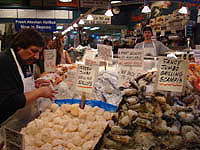 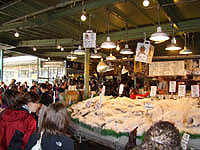
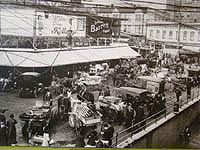 Pike Place Fish Market
is the most famous vendor in this whole market place. Their employees
throw fish across isles while breaking
into sing-songs when a sale was made. Many tourists stood outside the store to wait for its workers to break into sing-songs.
(upper middle photo). Pike Place Fish Market
is the most famous vendor in this whole market place. Their employees
throw fish across isles while breaking
into sing-songs when a sale was made. Many tourists stood outside the store to wait for its workers to break into sing-songs.
(upper middle photo).
However, we found the seafood displayed at another
vendor called Pure Food Fish Market
to be more impressive. This store was smaller, nor did its employees break into
sing-songs, but the scallops were as
big as tennis balls, lobster tails were at least 8 inches long, and countless
salmons that looked very fresh. (upper far-right photo.)
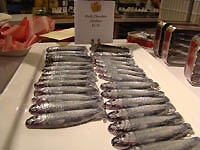
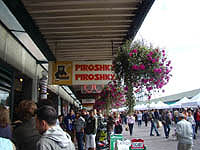
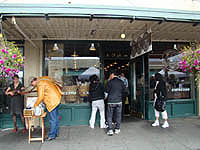 The first Starbucks coffee shop (opened in 1971) is also
located in the
Pike Place Market (left photo). The store attracts many tourists.
The first Starbucks coffee shop (opened in 1971) is also
located in the
Pike Place Market (left photo). The store attracts many tourists.
We followed our noses to the aroma of cinnamon butter and arrived at
the doorstep of a
Russian bakery called
Piroshky Piroshky
(photo in upper middle). We enjoyed their pastry immensely, so we went
back to buy more to bring home to Boston on the day we flew home.
By the way, have you ever tasted sardine-looking chocolate? We passed by
a chocolate shop that made
chocolate candy that looked like
sardines (photo on upper right.) I wonder whether one's brain will tell you it is sardines or whether it is
chocolate.
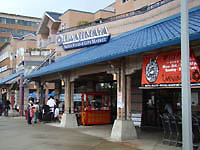
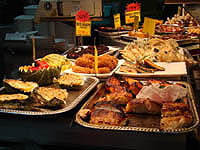 On
the next morning, we went to Seattle airport to meet up with the tour. After a
brief orientation in downtown Seattle, we made a lunch stop
at the huge Japanese market called Uwajimaya (宇和島屋, left photo) for 90
minutes. This area of Seattle is
called the International District, or Chinatown. We browsed Uwajimaya and
bought a lot of ready-to-eat food for a quick lunch. (Right photo.) On
the next morning, we went to Seattle airport to meet up with the tour. After a
brief orientation in downtown Seattle, we made a lunch stop
at the huge Japanese market called Uwajimaya (宇和島屋, left photo) for 90
minutes. This area of Seattle is
called the International District, or Chinatown. We browsed Uwajimaya and
bought a lot of ready-to-eat food for a quick lunch. (Right photo.)
Vancouver
Our tour spent two nights in Vancouver. We did not do
any group activities
while in Vancouver. Instead, we rented a car and tended to some family matters.
Our hotel was in Richmond, near Vancouver airport. We were told that Richmond has
grown into a new Asian town. There were many Asian businesses and restaurants in Richmond. Hotels and car rental
agencies also hired mandarin-speaking clerks. We enjoyed the wide selection of
reasonably priced food in Richmond.
Vancouver --> Kamloop --> Glacier National Park -->Golden
Our tour bus left Vancouver at 7am in the rain.
The rain did not let up the whole day. This was also a very long day on
the bus. However, Steven planned stops every 2 to 2.5 hours for us to visit something along
the way.
Before lunch, we stopped at Kamloops to visit a
ginseng farmers' corporation where we were treated to a very fragrant ginseng hot tea.
Many
team members purchased ginseng and its by-products. These ginseng farms
are operated by local Canadians.
In the afternoon, we drove through
Glacier National
Park to see "The Last Spike" and "Roger's Pass".
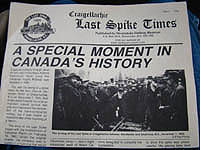
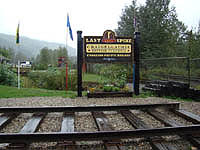 The
Last Spike of the Canadian Pacific Railway is where the
eastern-bound and western-bound railroad track meets, thus completing the Canadian Pacific Railway
connecting the east coast to the west coast. The
final spike driven was at a place called Craigellachie, British Columbia on
November 7, 1885. (Left photo.) The
Last Spike of the Canadian Pacific Railway is where the
eastern-bound and western-bound railroad track meets, thus completing the Canadian Pacific Railway
connecting the east coast to the west coast. The
final spike driven was at a place called Craigellachie, British Columbia on
November 7, 1885. (Left photo.)
Our guide, Steven, showed
us a copy of an old newspaper report about this significant event (right photo.) While visiting this landmark we saw another tour
bus full of tourists from Taiwan. We chatted with some tourists from that bus.
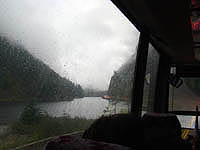
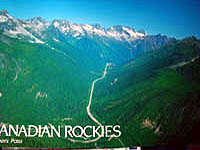 Roger's Pass is
a high mountain pass used by the Canadian Pacific Railway and the Trans-Canada Highway.
The pass is a shortcut across the "Big Bend" of the
Columbia River near
Golden. The pass was discovered on May 29, 1881 by Major
Albert Bowman Rogers, a surveyor working for the Canadian Pacific Railway,
thus the name. (Left photo.) Roger's Pass is
a high mountain pass used by the Canadian Pacific Railway and the Trans-Canada Highway.
The pass is a shortcut across the "Big Bend" of the
Columbia River near
Golden. The pass was discovered on May 29, 1881 by Major
Albert Bowman Rogers, a surveyor working for the Canadian Pacific Railway,
thus the name. (Left photo.)
It rained all day. At 5:30pm it was dark and foggy
outside, the mountain roads we were on looked forbidden (right photo). By the
time we reached a town called Golden for dinner and then checked into our hotel, it
was 9pm! Kudos to our bus driver for a long day's difficult drive.
Columbia Ice Field --> Banff ->
Canmore
Luckily, today was sunny and with blue sky. There was new
snow on the mountain tops since last night.
Today's major sight was the Columbia Icefield in Japser
National Park. Steven told us an "icefield" is like a "lake", and
"glaciers" are just like "rivers". Icefields feed into glaciers just like lakes
feed into rivers.
Columbia Icefield has a very spacious Visitors' Center (left photo) where one may find
restaurants, gift shops, restrooms and information pamphlets. We had a
group photo taken by a professional photographer in front of the visitor's
center. To go on to the glacier to reach the icefield we needed to ride a
special ice mobile
with big wheels (right photo).
The left photo below is a photocopy of the ice mobile's pamphlet
in multi-national language.
In the middle photo, the huge ice mountain in the
background behind us is the
Columbia Icefield.
The flat ice surface we stood on is a glacier named
Athabasca. The Athabasca glacier has been gradually shrinking over the
years. At one point in the past, the glacier could reach as far as the
Visitor Center's parking lot. Tourists were not allowed to go beyond the lines
of red warning signs (behind us in the middle photo), so we only stood on
the glacier, we did not step on the icefield. (Remember
the icefield feeds into a glacier? The Columbia Icefield feeds into the Athabasca glacier.)
On the right
is a photo of Vincent trying to catch melting ice water with a drinking bottle.
And here is our
video of 360 degree views as we stood on the glacier.
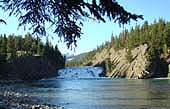 We continued on toward Banff, stopping at Bow Falls (pictured on the left).
Bow Falls is a major waterfall on the Bow River, near the premier resort hotel
of
(Fairmont) Banff Springs Hotel.
We continued on toward Banff, stopping at Bow Falls (pictured on the left).
Bow Falls is a major waterfall on the Bow River, near the premier resort hotel
of
(Fairmont) Banff Springs Hotel.
Many tourists visit the falls because of its proximity to the town of Banff.
The 1953 Marilyn Monroe movie The River of No Return shot scenes
here.
Steven showed a video of this movie on the bus on our way to Bow Falls.
In the late afternoon, the tour offered everyone an option to soak in a hot springs pool called "Banff Upper Hot Springs". For the
majority who did not want to do so, Steven and the bus driver took them to
downtown Banff for sight-seeing.
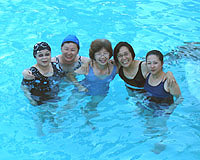
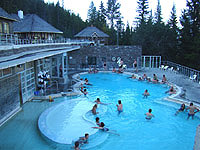 Eight
team members (5 women) opted to go to the pool. We brought our own bathing suite
and slippers, each paid $8 for admission, $1 to rent a towel, and $1 to rent a
locker, and there we were! Vincent did not change to get into the pool, he
walked around the premises and took photos for us. The pool did not have
water jets, and the water temperature (kept at 39C) was not as hot as the hot
springs we experienced in Japan in 2005. Over-all, this pool felt just
like a warm swimming pool. However, the beautiful scenery surrounding the pool
did make it special. Eight
team members (5 women) opted to go to the pool. We brought our own bathing suite
and slippers, each paid $8 for admission, $1 to rent a towel, and $1 to rent a
locker, and there we were! Vincent did not change to get into the pool, he
walked around the premises and took photos for us. The pool did not have
water jets, and the water temperature (kept at 39C) was not as hot as the hot
springs we experienced in Japan in 2005. Over-all, this pool felt just
like a warm swimming pool. However, the beautiful scenery surrounding the pool
did make it special.
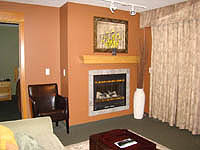
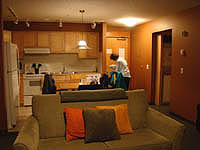
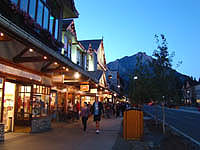 Our
tour group went to downtown Banff for a Korean BBQ dinner. Banff
is a beautiful town, upscale and bustling, lined with restaurants, bars,
shops and hotels to meet every tourist's needs. (Left
photo.) Our
tour group went to downtown Banff for a Korean BBQ dinner. Banff
is a beautiful town, upscale and bustling, lined with restaurants, bars,
shops and hotels to meet every tourist's needs. (Left
photo.)
Tonight we stayed at an upscale hotel called Windtower Lodge and Suite in Canmore,
about a 15-minute drive from Banff. The two of us got lucky
and were upgraded to a queen suite with a kitchen, living room and washer/dryer. (See
middle and right photo.)
Banff National Park (Canmore ---> Moraine Lake --> Lake Louise)
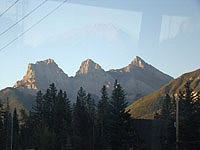
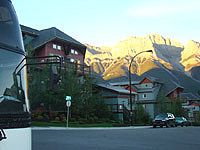 Like yesterday, today was a major sight-seeing day. We boarded our bus
at 7:30am. Outside our hotel in Canmore, the air was cool and crisp. We could see
mountains rising vertically right behind the houses across the street
(left photo).
Like yesterday, today was a major sight-seeing day. We boarded our bus
at 7:30am. Outside our hotel in Canmore, the air was cool and crisp. We could see
mountains rising vertically right behind the houses across the street
(left photo).
As our bus
left Canmore, Steven pointed out the Three Sisters Mountain (right
photo, the mountain with three peaks), and told us that this mountain was featured
in director Ang Lee's 2005 movie "Brokeback Mountain".
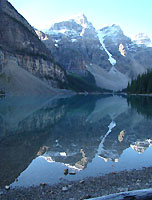
_200.jpg) Our first stop this morning was Moraine Lake. (Photos on left and right.)
Our first stop this morning was Moraine Lake. (Photos on left and right.)
The word Moraine means
accumulated glacial debris. To make a long story short, Steven told us
that this lake was wrongly named, because rocks surrounding this lake were proven to be not accumulated glacier debris.
Moraine Lake is surrounded by 10 peaks; its picture is on the back
of an old
Canadian $20 bill. Some may say Moraine Lake is more beautiful than Lake
Louise, but Mei-Ching likes Lake Louise better.
Our next stop was Lake Louise, named after Princess Louise, the 4th daughter of
Queen Victoria of Great Britain. When Princess Louise married the
Marquess of Lorne, then the
Governor General of Canada, the lake was named after her to honor her.
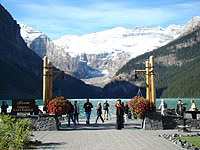
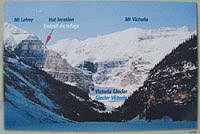 As
you may see from the brochure (left photo), the composition of this
spectacular view is the emerald Lake Louise sitting right below
Glacier Victoria which covers part of Mt. Victoria. Therefore, in this space,
mother overlooks her daughter forever in eternity. As
you may see from the brochure (left photo), the composition of this
spectacular view is the emerald Lake Louise sitting right below
Glacier Victoria which covers part of Mt. Victoria. Therefore, in this space,
mother overlooks her daughter forever in eternity.
The right photo is a view of the lake and glacier and the
promenade of the Fairmont Chateau Lake Louise. This chateau provides
visitors with all the creature's comfort - restaurants, restrooms, gift
shops, and lodging etc. Behind the chateau (and away from the lake) there
is a new Courtyard hotel. Steven said that rooms at the Courtyard can be
had for $200+/night. Mei-Ching likes this area more than Moraine Lake, for
the wider lake and open space here, and for the Chateau, which provides modern-day comfort on site.
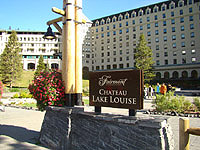
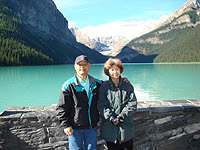 In
the lounge of Chateau Lake Louise there was a female harpist who started
playing a pop song called "The Moon Represents My Heart" as soon
as she saw our group walking in. (This song is sung in Mandarin lyrics, and
is very popular in Taiwan and Hong Kong.) We loved her
playing and bought a CD recording of her work. Here is a
video
of her playing this pop song. The harpist has a website
at www.harpangel.com In
the lounge of Chateau Lake Louise there was a female harpist who started
playing a pop song called "The Moon Represents My Heart" as soon
as she saw our group walking in. (This song is sung in Mandarin lyrics, and
is very popular in Taiwan and Hong Kong.) We loved her
playing and bought a CD recording of her work. Here is a
video
of her playing this pop song. The harpist has a website
at www.harpangel.com
And here is
our
video
of 180 degree views of Lake Louise.
Seattle and Rick Steves' Edmonds
The tour bus took us back to Seattle airport, thus concluded our
Canadian Rockies tour. We stayed one extra day in a Courtyard hotel in
Seattle to meet with Mei-Ching's college classmate Jo, and to go to Edmonds to see Rick Steves'
Travel Center.
Jo kindly offered to drive us for the day and give us a tour of her beloved city. On our way to Edmonds, she took us to a beautiful waterfront park by Lake
Washington, saw the University of Washington campus, and to a Fish Ladder built
to help salmons swim upstream during their spawning seasons. Our visit to the fish ladder was
very educational. We also found out Jo is a travel buff. She went to Turkey with OAT (Overseas
Travel Adventure) this past April, a trip we almost took before we decided to go to Sicily instead.
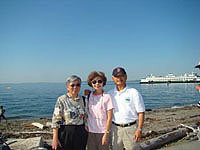
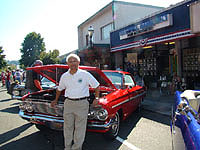
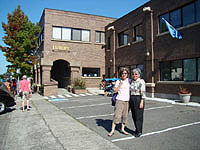 The brick building
in the left photo is Rick Steves' Travel Center
in Edmonds, one hour drive north of Seattle. We have mail-ordered travel bags,
Eurail passes and various travel accessories from Rick's
Travel Center. We have used Rick's guide books to plan many European trips since 1997, so now that
we were in Seattle, how could we not go to Edmonds to take a look at Rick's
headquarters?
Although the travel center was closed on Sundays, we took a peek through its windows
and took pictures in front of the building.
(The sign on Rick's building says Rick Steves' EUROPE THROUGH THE BACK DOOR). The brick building
in the left photo is Rick Steves' Travel Center
in Edmonds, one hour drive north of Seattle. We have mail-ordered travel bags,
Eurail passes and various travel accessories from Rick's
Travel Center. We have used Rick's guide books to plan many European trips since 1997, so now that
we were in Seattle, how could we not go to Edmonds to take a look at Rick's
headquarters?
Although the travel center was closed on Sundays, we took a peek through its windows
and took pictures in front of the building.
(The sign on Rick's building says Rick Steves' EUROPE THROUGH THE BACK DOOR). Edmonds downtown was quaint and bustling, it happened to have an antique car show
going on. Vincent saw a red Impala which looked just like the 1962 red
Impala brother-in-law Ken and sister Susan gave him in 1969. Vincent posed for
a photo in front of this red Impala for nostalgic
reasons (middle photo). During a coffee break at a pastry shop, we had an interesting chat
with an antique car owner named Jan Polroy. Jan grew up in Edmunds and told us
many interesting local stories. However, when we told him we came all the way
to Edmonds to see Rick Steves' Travel Center, his response was "Rick Who?", and
he did not appear to be kidding. Maybe Rick is not widely known in his
own home town? (Note: Rick Steves is
the travel guru often seen on PBS TV. He specializes in European destinations. See
http://www.ricksteves.com.)
The photo with Jo (right photo) is near Edmonds' ferry dock. The body
of water behind us is the Puget Sound.
We took a red-eye flight home and arrived at Boston in the afternoon of
9/14, thus concluding a trip of many highlights and lasting memories. Our tour to the
Canadian Rockies was indeed very rushed. To do it properly, one may consider flying
into and out of Calgary to save time on driving, and to spend a few extra days in
the Banff area to
enjoy the beautiful scenery.
|